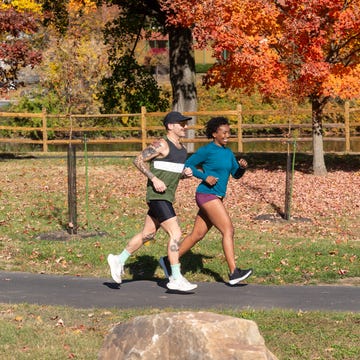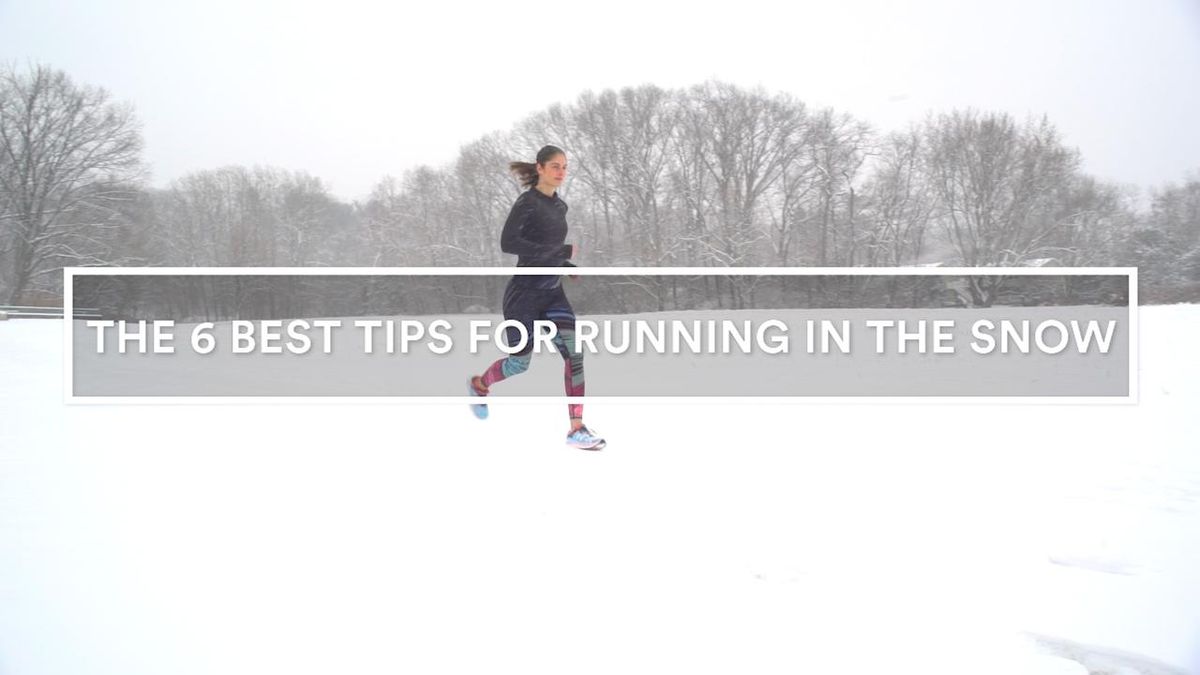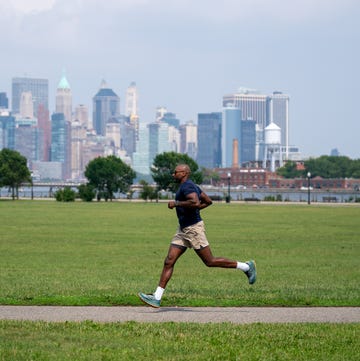1Day 1: Commit
“Committing to something is less about having time and more about setting priorities,” says Nicole Detling, Ph.D., assistant professor at the University of Utah, and author of Don't Leave Your Mind Behind: The Mental Side of Performance. As your holiday schedule ramps up, add workouts to the calendar on your phone and consider them meetings you can’t cancel.
Read more here.
2Day 2: No regrets
“How many runs do you ever regret going on? Nine out of 10 times, you feel better, happier, and have a clearer head for having spent a few minutes out in nature—or the urban jungle. The other half comes from a place of gratitude. Just appreciate the opportunity that you have to be out there,” says Kaitlin Gregg Goodman, pro distance runner.
Read more here.
Advertisement - Continue Reading Below
3Day 3: What to wear
Remember, no matter what the temperature says, your body is going to heat up as soon as you start moving. A solid rule of thumb: Dress like it’s 15 to 20 degrees warmer than it actually is.
“You should be uncomfortable standing outside as you wait for your watch to sync,” says Elizabeth Corkum, a New York City-based running coach. “If you’re fine simply standing outside, the odds are good you’ll overheat once you warm up into your run.”
The What-to-Wear Tool
4Day 4: No goals, no problem
Advertisement - Continue Reading Below
5Day 5: Take a tech detox
“Every once in a while, it’s good to give yourself a tech detox,” says Roberto Mandje, Senior Manager of Training and Education for New York Road Runners. “You’ll find you’re less tempted to chase a certain pace and instead are more likely to run by listening to your body’s many cues.”
Read more here.
6Day 6: Go easy
The easy day run is the Rodney Dangerfield of distance training: It receives precious little respect.
Read more here.
Advertisement - Continue Reading Below
7Day 7: Refuel
It’s critical to refuel within 30 minutes to an hour of finishing a workout. Aim for a 3:1 carb-to-protein ratio. Try options such as a protein shake with fruit, a bagel with protein (such as an egg or peanut butter), or cereal and milk.
Read more here.
8Day 8: Hitting the trails
Generally, trail running is a much more intense total-body workout than road running. Plan your trail run based on time, not mileage, and try looking at it from a bigger perspective, like how long it takes you to do a certain loop or finish a climb in one section.
Read more about trail running.
Advertisement - Continue Reading Below
9Day 9: Layer up
Dressing in layers is the key to running comfortably all winter. You can start the run feeling warm, then easily shed the layers as your body warms up and you need less clothing. Simply tie unneeded layers such as jackets or long sleeve shirts around your waist and keep running once you’re warm, or plan a loop run so you can drop them off in a safe spot—like your car—when you don’t need them.
Read more here.
10Day 10: Watch your form
You might think running is all about your lower body, but your run technique needs to be dialed in from the top down. That said, don’t look at your feet. “Be sure to gaze directly in front of you,” says Kelli Fierras, a USATF-certified running coach.
Read more here.
Advertisement - Continue Reading Below
11Day 11: Give yourself a carrot
Give yourself a carrot: Luring yourself out the door with the promise of a reward at the end—whether it be a catch-up with a friend or brunch—works. “Set a date to meet someone for a run,” says Jean M., a Runner’s World reader in Colorado. “There’s no wimping out when someone is waiting.”
Read more here.
12Day 12: Tempo pace
How do you calculate your tempo pace? Without getting too technical, tempo pace is the effort level at which your body is able to clear as much lactate—a byproduct of burning carbohydrates—as it produces. Your body’s lactate clearance is at the same level as its lactate production, meaning the dreaded dead-leg sensation doesn’t set in.
That’s the key difference between a race and a tempo run. In an all-out session, your body bypasses this limit, allowing for fatigue to develop rapidly. A tempo pace, on the other hand, can be held steadily (albeit not too comfortably) for at least 20 minutes.
Read more here.
Advertisement - Continue Reading Below
13Day 13: When to stretch
Running with stiff, tight muscles is not only hard, but it can also set you up for injury if you make it a habit. So doing a few running stretches regularly to maintain or improve your flexibility and range of motion is an essential part of training.
You may wonder: Should you stretch before running or after running? Here’s what the experts have to say.
Read more here.
14Day 14: Reflect on your 2021
The Strava Year in Sport 2021 report is out, showing just how much we ran this year. Even as variants of COVID-19 slowed the world down, more and more people picked up new forms of exercise. In fact, there was a 38 percent year-over-year increase in logged activities.
Read more here.
Advertisement - Continue Reading Below
15Day 15: Running for weight loss
Running longer at a lower intensity will burn a lot of calories, but running short and fast can burn just as many, if not more, once you factor in that higher post-run calorie burn. That doesn’t mean you should only do high-intensity interval training; any good training plan will consist of a variety of running paces, all of which have their own benefits. But if weight loss is a priority for you, don’t skip your sprints!
Read more here.
16Day 16: Find a new playlist
Whether you’re running outside or just hitting the treadmill, good music can often make the difference between a rave run and a blown goal.
Try a new running mix.
Advertisement - Continue Reading Below
17Day 17: Mix it up
Sometimes a change of scenery can be just the thing to refresh your running routine. Maybe that same old out-and-back is starting to feel a little stale, or your usual path has gotten a tad too crowded for your liking. Whether you’re new to an area, just starting out as a runner, or simply looking for some different views on your daily outing, a running route planner lends some convenience and variety to your fitness journey.
Read more here.
18Day 18: Sexy pace
How slow is slow? Well, slow is a relative term. “I actually don’t like to use that word when I coach, because I think it gives people a negative connotation, and then that’s why they don’t want to do it,” says Jessie Zapotechne, a coach with Adidas Runners in New York City and the founder of Girls Run NYC. “Instead, we’ll call it a recovery run or sexy pace.”
What that really means is that you’re running at a pace that doesn’t tax your body. “It’s when you can hold a conversation while running,” she says—and not just with one-word responses.
Read more here.
Advertisement - Continue Reading Below
19Day 19: Running in the snow
“The key to running safely on snow and ice is to remember it will take a heck of a lot more energy than running without snow, and you will need to think ahead and modify your pace,” says Jenny Hadfield, running coach and author of Running for Mortals. “Although you will likely not run your fastest on snow and ice, you will certainly get a tough run in and one that will challenge your strength, balance, and focus.”
Read more here.
20Day 20: Don’t go HAM on every run
If you go hard every single day, you’re going to set yourself up for overtraining issues and burnout. A run streak is about varying intensities; running slow (or even walking) helps balance the stress of a workout with active recovery. “Active recovery helps get blood flow back to the muscles so they can heal,” says Tracie Hunter, an RRCA-certified running coach in Zionsville, Indiana. “Those easy efforts also help your ligaments, bones, and joints recover from the stress you put them under in a workout”—a lot more than sitting on the couch might.
Read more here.
Advertisement - Continue Reading Below
Readers Also Read
Advertisement - Continue Reading Below
Advertisement - Continue Reading Below

































